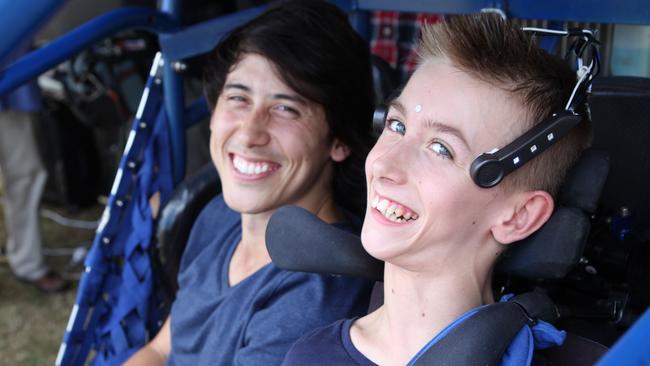‘Superhuman’ technology gives us control with the blink of an eye
A BIOMEDICAL engineer’s work to help a boy become “superhuman” could soon see us all control incredible powers.
TV
Don't miss out on the headlines from TV. Followed categories will be added to My News.
WHAT started as mission to make a 13-year-old with cerebral palsy’s dream of independence come true could see all of us all become superhuman — able to control our environment not just in — but with — the blink of an eye..
That’s the potential for brain-computer interface technology developed by Sydney biomedical engineer Jordan Nguyen who aims to deliver ‘telekinetic control’, the ability to control technology with eye movement.
The cutting-edge technology inspired by futuristic Hollywood blockbusters like X-Men could see even the least ambitious among us fulfil idle dreams of being able to turn on the TV and dim the lights without moving a muscle or reaching for a remote.
But for Dr Nguyen, 31, whose work with Riley Saban to make him “superhuman” is showcased in a two-part ABC Catalyst special starting tomorrow night, it was first about honouring a promise.
Riley was born with cerebral palsy, which leaves him wheelchair-bound, and largely unable to move because of limited voluntary control over his body.
He speaks with the help of a computer that tracks eye movement as he moves from one letter to the next, and spells out what he wants to say.
And what he’s saying loudest is her wants independence: the ability to turn on a light, switch on the TV or the computer. Oh, and while you’re at it, he’d quite like to learn to drive.
As a child Riley played an imaginary game of trying to turn the lights on, start the microwave, switch on the TV, with his mind.

He’d stare hard at the object, willing it to turn on. Once, his mum laughs, the TV channel coincidentally changed. “He thought he was a superhero,” she says.
Turns out Riley’s imaginary games were on the right track, they were the starting point for Dr Nguyen and his team.
Riley's most reliable voluntary movement is his eyes, so the aim was to harness the power of the brain via the optic nerve, tapping into the brain’s electrical signals to do it.
Dr Nguyen describes the result as a form of telekinesis, tracking eye movement so that the brain’s electrical waves are converted to a command, sending that commend to a computer, and using artificial intelligence technology to complete the process.
“It sounds a lot simpler than it is. But the end result is being able to control things with the eyes — moving, controlling, turning on an object — without touching it. Instead the impetus comes from the electrical activity of the brain,” Dr Nguyen says.
Think of it like an electric guitar. “Electric guitars take the small signals from the vibration on the string, they amplify it making it bigger, they filter it to make it sound nice, and then they transmit that signal and then wherever it gets transmitted to, (in Riley’s case a computer which learns to read signals sent by an electrode-studded headband transmitter). It’s like telling the difference between a chord,” Dr Nguyen says.

“This has huge implications for the future. One day we might all be able to control our technology with our own biology. One day we might all be able to become superhuman,” says Dr Nguyen.
“In essence, what it is doing is picking up the electrical activity of the brain using electrodes. In this case rather than implant them we made an interface that can be placed on the head. It’s a headband.”
“The implications for wider use are huge. As this technology advances we will be able to control things in a more natural way. You’ll be able to wear headsets, they will be able to be built into new technology that we control with our brainwaves.
“We are moving towards a future where we are able to bridge the gap between human biology and technology. Right now that interaction tends to be very mechanical. This moves us into an area where our biology becomes a lot more connected with the world around us”
But right now, Riley is the superhero in the scenario, the inspiration for the technology, and vital to its development.
“He had very specific things we needed to do and he never gave up. His brain was working over time to learn to use his eyes as a controller. Eyes are usually only used for input not for output as a controller,” says Dr Nguyen.
“Even his childhood staring thing, there was scene in the first X-Men movie where there was a kid siting on the couch watching TV and blinking their eyes, and every time the kid blinked the TV would change channel. And I looked at that and realised ‘that’s possible’.
“So hearing Riley had done the same sort of thing, I knew we had to find a way.”
This isn’t the first time Dr Nguyen has delivered on his pledge to make cutting edge technology deliver independence to people with disabilities and harness the power of the mind to do it. In 2012 he completed development of a mind-controlled wheelchair which steers away from obstacles using an artificial intelligence system.

His quest to develop technology for people with disabilities was sparked at the age of 21 when a leap off a diving board went wrong. His head hit the bottom of the pool and he was paralysed for 24 hours with an almost-broken neck.
Wondering if he’d spend the rest of his life in a wheelchair changed his perspective and started him thinking about mind control and the ability to move things with thoughts.
And Riley has no plans to stop with just turning on the TV. He wants to be a technology engineer, like Dr Nguyen.
“I think mind control could change the world and allow physically disabled people just like myself to be more independent,” he says.
“We will have more input into society. I want to change the bloody world.”
Jordan and Riley’s story starts on Tuesday on Catalyst, 8pm, ABC
Originally published as ‘Superhuman’ technology gives us control with the blink of an eye



